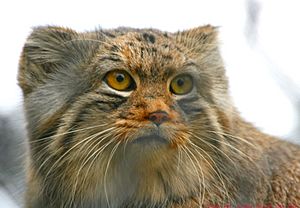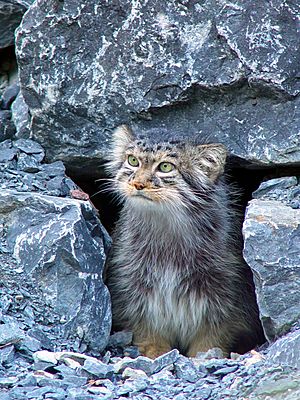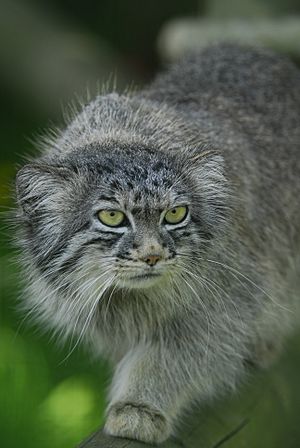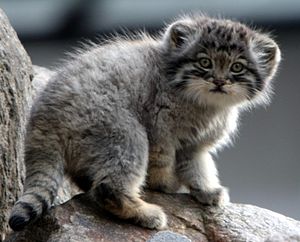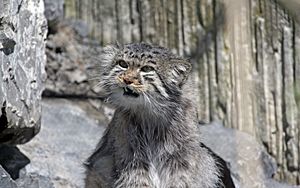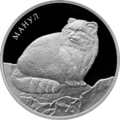Pallas's cat facts for kids
Quick facts for kids Pallas' Cat |
|
|---|---|
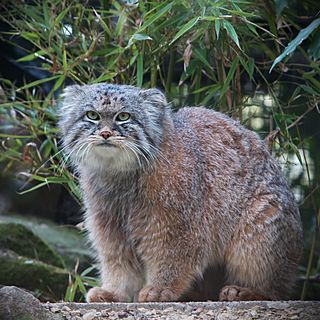 |
|
| Manul at Rotterdam Zoo | |
| Conservation status | |
| Scientific classification | |
| Kingdom: | |
| Phylum: | |
| Class: | |
| Order: | |
| Family: | |
| Genus: | |
| Species: |
F. manul
|
| Binomial name | |
| Felis manul Pallas, 1776
|
|
The Pallas's cat, also called manul, is a small wild cat. It lives in the grasslands and steppes of Central Asia. Its home is spread out but also broken up into smaller areas.
This cat is one of the oldest types of cats alive today. Fossils show that Pallas's cats have been around for 10 million years. People once thought they were related to Persian cats because of their unique faces.
Sadly, their homes are shrinking, their food is disappearing, and they are hunted. Because of this, the Pallas's cat has been listed as "Near Threatened" by the IUCN Red List since 2002. A German scientist named Peter Simon Pallas first described this cat in 1776.
Contents
What Pallas's Cats Look Like
The Pallas's cat is about the same size as a house cat. Its body is about 46 to 65 cm (18 to 26 in) long. Its tail adds another 21 to 31 cm (8.3 to 12.2 in). It weighs about 2.5 to 4.5 kg (5.5 to 9.9 lb).
This cat looks stout and fluffy because of its stocky body and long, thick fur. Its fur is a yellowish-brown color with dark stripes on its body and front legs. In winter, its coat becomes grayer and has fewer patterns. Its tail has clear black rings, and its forehead has dark spots. The cheeks are white with thin black stripes coming from the corners of its eyes. Its chin and throat are also white, blending into the gray, silky fur on its belly.
Pallas's cats have shorter legs than other cats. Their ears are set very low and far apart. Their claws are also unusually short. Their face looks flattened compared to other cats. Their pupils are round, not like the vertical slits seen in many other cats. They have fewer teeth than most cats, but their canine teeth are large.
Where Pallas's Cats Live
Pallas's cats live in the steppe regions of Central Asia. They can be found at very high places, up to 5,050 meters (16,570 ft) in the Tibetan Plateau. They also live in parts of Afghanistan, Mongolia, Tajikistan, Kyrgyzstan, Nepal, India, Kazakhstan, and Pakistan. They are also found across much of western China.
In southern Russia, they live in the Transbaikal Krai. They are less common in the Altai, Tyva, and Buryatia Republics. In 1997, they were seen for the first time in the eastern Sayan Mountains.
The groups of Pallas's cats near the Caspian Sea, in Afghanistan, and Pakistan are thought to be shrinking. They are also becoming more separated from each other.
Pallas's Cat Behavior
Pallas's cats are mostly alone. Both male and female cats mark their territory with scent. They spend their days resting in caves, cracks in rocks, or in burrows made by marmots. They come out in the late afternoon to start hunting.
What Pallas's Cats Eat
Pallas's cats hunt at night. They look for small mammals and birds on the ground. They mostly eat animals that are active during the day, like gerbils, pikas, voles, and chukar partridges. Sometimes, they catch young marmots.
They are not fast runners. Instead, they hunt by waiting in ambush or by sneaking up on their prey. They use low plants and rocky areas to hide.
Pallas's Cat Life Cycle and Reproduction
Pallas's cats usually have a litter of two to six kittens. The mother carries the babies for 66 to 75 days. Kittens are typically born in April or May. Having many kittens helps make up for the high number of young cats that might not survive in their tough environment.
The young are born in safe dens. These dens are lined with dried plants, feathers, and fur. Newborn kittens weigh about 90 grams (3.2 oz). They have a thick, fuzzy coat of fur. This fur is replaced by their adult coat after about two months. They can start hunting when they are four months old. They reach their full adult size at six months. Pallas's cats have been known to live up to 11 years when cared for in zoos.
Threats to Pallas's Cats
Pallas's cats have been hunted for their fur in places like China, Mongolia, and Russia. However, the international trade of their fur mostly stopped in the late 1980s. About 1,000 hunters still hunt Pallas's cats in Mongolia. They are estimated to catch about 2,000 cats each year.
Cats are also sometimes shot by mistake when hunters are looking for marmots. They can also get caught by accident in traps meant for wolves, foxes, or hares. Herding dogs also sometimes kill them. In Mongolia and Russia, their fat and organs are used as medicine. While Mongolia has not reported exporting any cats for trophies, fur exports have increased since 2000. For example, 143 furs were reported exported in 2007.
Protecting Pallas's Cats
The Pallas's cat is listed in CITES Appendix II. This means that trade in these animals is controlled. Hunting them is against the law in all countries where they live, except for Mongolia. In Mongolia, the species has no legal protection, even though it is listed as Near Threatened there. Since 2009, Pallas's cats have been legally protected in Afghanistan. All hunting and trade of their body parts are banned there.
Scientists are studying the Pallas's cat in the Daursky Nature Reserve in Russia. They want to learn more about where the cats live and how they move around. They also want to find out how many kittens and adult cats survive.
As of 2010, there were 47 Pallas's cats in 19 zoos that are part of the Association of Zoos and Aquariums. It can be hard to keep Pallas's cats healthy in zoos. They breed well, but many young cats do not survive. This is often due to infections. It is thought that their immune systems might not be fully developed. They might also be exposed to viruses that are not found in their natural high-altitude homes.
Images for kids
See also
 In Spanish: Manul para niños
In Spanish: Manul para niños



